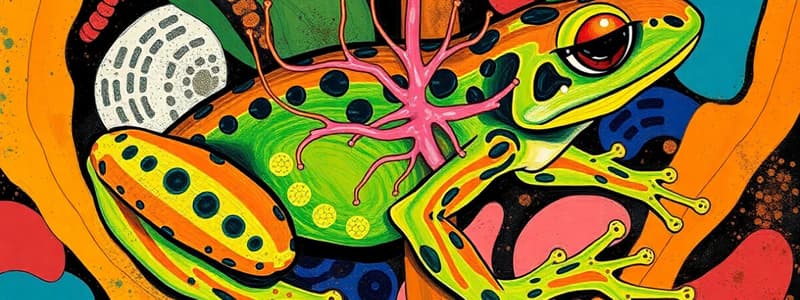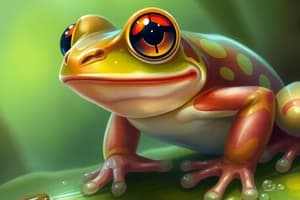Podcast
Questions and Answers
In frogs, what primarily coordinates the functions of various organs in the body?
In frogs, what primarily coordinates the functions of various organs in the body?
- Hormones secreted by endocrine glands (correct)
- The combined action of the kidneys and liver
- Electrical impulses transmitted by nerves
- The interaction between the central and peripheral nervous systems
Which of the following is NOT a prominent endocrine gland found in frogs?
Which of the following is NOT a prominent endocrine gland found in frogs?
- Adrenal
- Gallbladder (correct)
- Pituitary
- Thyroid
What constitutes the central nervous system in frogs?
What constitutes the central nervous system in frogs?
- Brain and spinal cord (correct)
- Sensory and motor neurons
- Sympathetic and parasympathetic nerves
- Cranial and spinal nerves
How many pairs of cranial nerves arise from the brain of a frog?
How many pairs of cranial nerves arise from the brain of a frog?
Which structure encloses the brain in a frog?
Which structure encloses the brain in a frog?
What are the main divisions of the frog's brain?
What are the main divisions of the frog's brain?
Which part of the frog's brain includes olfactory lobes, paired cerebral hemispheres, and unpaired diencephalon?
Which part of the frog's brain includes olfactory lobes, paired cerebral hemispheres, and unpaired diencephalon?
The midbrain in frogs is characterized by which of the following?
The midbrain in frogs is characterized by which of the following?
Which structures constitute the hind-brain in frogs?
Which structures constitute the hind-brain in frogs?
Through which opening does the medulla oblongata pass out to continue into the spinal cord?
Through which opening does the medulla oblongata pass out to continue into the spinal cord?
Which of the following is NOT a sense organ found in frogs?
Which of the following is NOT a sense organ found in frogs?
What structure in frogs is responsible for hearing and balancing?
What structure in frogs is responsible for hearing and balancing?
What type of eyes do frogs have?
What type of eyes do frogs have?
Which part of the ear is absent in frogs?
Which part of the ear is absent in frogs?
What is the function of the ear in frogs?
What is the function of the ear in frogs?
How are the testes attached to the kidneys in male frogs?
How are the testes attached to the kidneys in male frogs?
What are vasa efferentia and what is their role in the male frog reproductive system?
What are vasa efferentia and what is their role in the male frog reproductive system?
How many vasa efferentia are typically found arising from each testis in a frog?
How many vasa efferentia are typically found arising from each testis in a frog?
Where do the vasa efferentia ultimately lead in the male frog reproductive system?
Where do the vasa efferentia ultimately lead in the male frog reproductive system?
What term describes animals that excrete urea as their primary nitrogenous waste product, like frogs?
What term describes animals that excrete urea as their primary nitrogenous waste product, like frogs?
Flashcards
What is a ureotelic animal?
What is a ureotelic animal?
Excretes urea
Prominent endocrine glands in frog
Prominent endocrine glands in frog
Pituitary, thyroid, parathyroid, thymus, pineal body, pancreatic islets, adrenals, and gonads
Central nervous system
Central nervous system
Brain (cranial and spinal nerves)
Peripheral nervous system
Peripheral nervous system
Signup and view all the flashcards
Autonomic nervous system
Autonomic nervous system
Signup and view all the flashcards
What does the forebrain include?
What does the forebrain include?
Signup and view all the flashcards
What characterizes the midbrain?
What characterizes the midbrain?
Signup and view all the flashcards
What does the hindbrain consist of?
What does the hindbrain consist of?
Signup and view all the flashcards
Different types of sense organs
Different types of sense organs
Signup and view all the flashcards
Function of the ear
Function of the ear
Signup and view all the flashcards
Male reproductive organs in frogs
Male reproductive organs in frogs
Signup and view all the flashcards
What is mesorchium?
What is mesorchium?
Signup and view all the flashcards
How many Vasa efferentia are present on the testes?
How many Vasa efferentia are present on the testes?
Signup and view all the flashcards
Study Notes
- Frogs are ureotelic animals: they excrete urea.
- Excretory wastes are transported by blood to the kidney, where they are separated and excreted.
- Control & coordination in frogs relies on both neural and endocrine systems.
- Hormones secreted by endocrine glands coordinate bodily functions.
- Prominent endocrine glands in frogs: pituitary, thyroid, parathyroid, thymus, pineal body, pancreatic islets, adrenals, and gonads.
Nervous System
- The nervous system consists of:
- A central nervous system (brain and spinal cord).
- A peripheral nervous system (cranial and spinal nerves).
- An autonomic nervous system (sympathetic and parasympathetic).
- There are ten pairs of cranial nerves arising from the brain.
- The brain is enclosed in a bony structure called the cranium.
- The brain is divided into forebrain, midbrain, and hindbrain.
- The forebrain includes olfactory lobes, paired cerebral hemispheres, and unpaired diencephalon.
- The midbrain is characterized by a pair of optic lobes.
- The hindbrain consists of the cerebellum and medulla oblongata.
- The medulla oblongata passes out through the foramen magnum and continues into the spinal cord, which is enclosed in the vertebral column.
Sense Organs
- Frogs have various sense organs:
- Touch (sensory papillae).
- Taste (taste buds).
- Smell (nasal epithelium).
- Vision (eyes).
- Hearing (tympanum with internal ears).
- Eyes and internal ears are well-organized structures.
- Other sensory structures are cellular aggregations around nerve endings.
- Frog eyes are a pair of spherical structures in the orbit of the skull and possess one unit.
- Frogs lack an external ear; only the tympanum can be seen externally.
- The ear functions in hearing and balancing (equilibrium).
Reproductive System
- Frogs have well-organized male and female reproductive systems.
- Male reproductive organs consist of a pair of yellowish ovoid testes.
- Testes are adhered to the upper part of the kidneys by a double fold of peritoneum called mesorchium.
- Vasa efferentia: 10-12 in number, arise from testes, enter the kidneys on their side, and open into Bidder's canal.
Studying That Suits You
Use AI to generate personalized quizzes and flashcards to suit your learning preferences.




